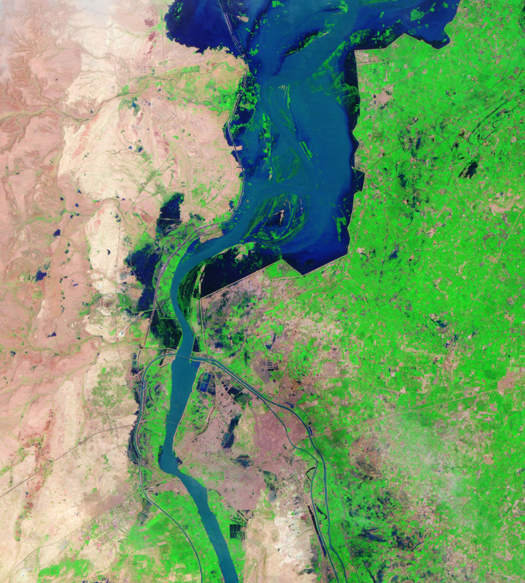
[Flooding on the Indus river around Hyderbad, Pakistan, 19 August 2010; image via NASA Earth Observatory.]
At Weather Underground, Jeff Masters reflects on the extreme weather of 2010 — which included monsoon flooding in China, the Pakistani floods (the most expensive disaster in Pakistan’s history), the Queensland flood (Australia’s most expensive natural disaster), Colombia’s record rains and flooding (also the most expensive disaster in that nation’s history), and the thousand-year flood in Nashville:
“It is difficult to say whether the weather events of a particular year are more or less extreme globally than other years, since we have no objective global index that measures extremes. However, we do for the U.S.–NOAA’s Climate Extremes Index (CEI), which looks at the percentage area of the contiguous U.S. experiencing top 10% or bottom 10% monthly maximum and minimum temperatures, monthly drought, and daily precipitation. The Climate Extremes Index rated 1998 as the most extreme year of the past century in the U.S. That year was also the warmest year since accurate records began in 1895, so it makes sense that the warmest year in Earth’s recorded history–2010–was also probably one of the most extreme for both temperature and precipitation. Hot years tend to generate more wet and dry extremes than cold years. This occurs since there is more energy available to fuel the evaporation that drives heavy rains and snows, and to make droughts hotter and drier in places where storms are avoiding. Looking back through the 1800s, which was a very cool period, I can’t find any years that had more exceptional global extremes in weather than 2010, until I reach 1816. That was the year of the devastating “Year Without a Summer”–caused by the massive climate-altering 1815 eruption of Indonesia’s Mt. Tambora, the largest volcanic eruption since at least 536 A.D. It is quite possible that 2010 was the most extreme weather year globally since 1816.
…I don’t believe that years like 2010 and 2011 will become the “new normal” in the coming decade. Many of the flood disasters in 2010 – 2011 were undoubtedly heavily influenced by the strong El Niño and La Niña events that occurred, and we’re due for a few quiet years without a strong El Niño or La Niña… But the ever-increasing amounts of heat-trapping gases humans are emitting into the air puts tremendous pressure on the climate system to shift to a new, radically different, warmer state, and the extreme weather of 2010 – 2011 suggests that the transition is already well underway. A warmer planet has more energy to power stronger storms, hotter heat waves, more intense droughts, heavier flooding rains, and record glacier melt that will drive accelerating sea level rise. I expect that by 20 – 30 years from now, extreme weather years like we witnessed in 2010 will become the new normal.”
Read the full post at the Weather Underground.


Speaking of patterns, the hard-line levees in the post above highlights the the curious effect of humans on the boundaries of water.
Here you have the rationalist affect caused by water filling up straight-line levees, but in the “six dams and six rivers post,” the water that fills up old valleys takes reveals a fractal like boundary at the surface. Rivers, meanwhile, maintain their curvilinear forms, stuck as they always are, to the old ways.
Yes — and if you look at the comparative, non-flood stage image of the Indus at Earth Observatory, you see that the rigid geometry produced by the levees is a fleeting phenomenon.
[…] that they were intended to, they have also created unanticipated problems, face what appear to be a growing regime of unprecedented challenges, and will not last forever, particularly at today’s absymal maintenance […]